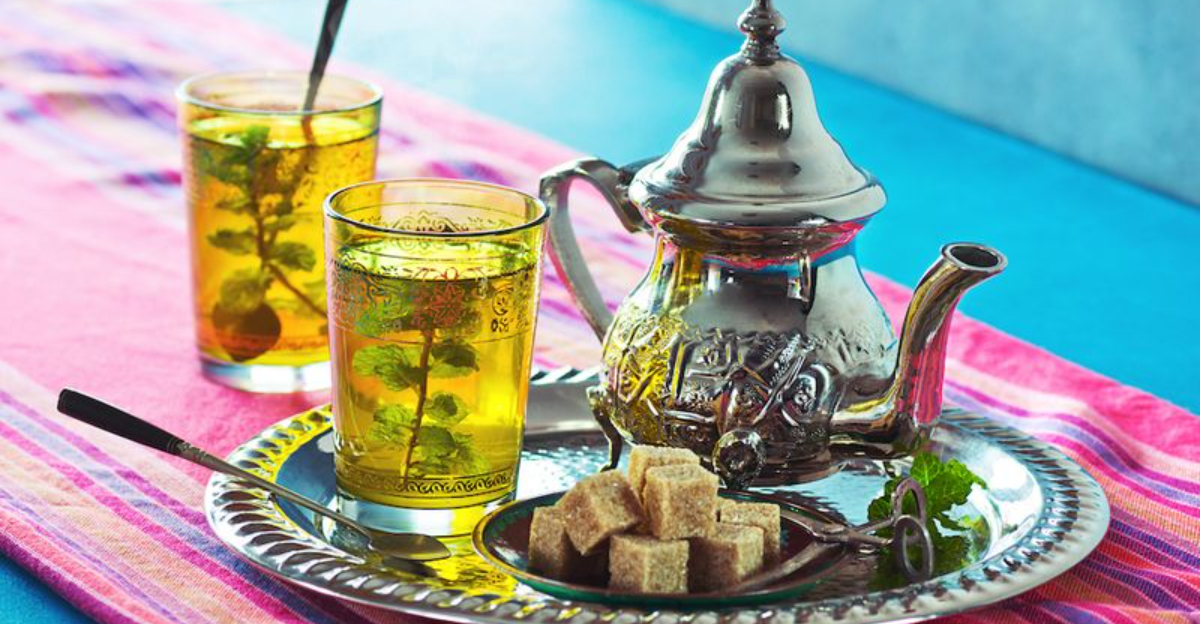15 Teas From Across The Globe That Belong In Your Cup

Tea isn’t just a drink but a worldwide journey in a cup! From misty mountains in China to bustling markets in Morocco, people everywhere have their own special way of brewing this beloved beverage.
Join me as we explore amazing teas that tell stories of different cultures, traditions, and flavors waiting to be discovered in your next cuppa.
1. Matcha: Japan’s Vibrant Green Powerhouse
Whisked to frothy perfection, matcha transforms tea drinking into a meditative art form! This powdered green tea contains the entire tea leaf, delivering a caffeine kick that feels different from coffee—steady energy without the jitters.
I still remember my first matcha ceremony in Kyoto, where the tea master’s hands moved with such precise grace. The grassy, umami flavor might surprise you at first, but soon becomes addictively comforting.
2. Darjeeling: The Champagne of Teas
Grown in the misty foothills of the Himalayas, Darjeeling tea boasts a delicate muscatel flavor that tea connoisseurs chase worldwide. The amber-colored brew changes character with each season’s harvest, making it endlessly fascinating.
First flush (spring) Darjeeling offers light, floral notes, while second flush brings deeper, fruitier dimensions. Sip it plain to appreciate the complex layers that earned this Indian treasure its prestigious nickname.
3. Moroccan Mint: Sweet Desert Refreshment
Poured from dizzying heights into tiny glasses, Moroccan mint tea combines gunpowder green tea with fresh spearmint and heaps of sugar. The theatrical pouring creates a frothy top that’s as much about hospitality as it is about taste.
During my travels through Marrakech, I was offered this sweet brew everywhere I went. Refusing would have been unthinkable!
The mint provides cooling relief from desert heat while the sugar delivers quick energy—desert wisdom in liquid form.
4. Pu-erh: China’s Fermented Treasure
Pu-erh breaks all tea rules by actually improving with age! This fermented Chinese tea develops complex flavors over decades, with vintage cakes fetching thousands of dollars among collectors. The earthy, woodsy taste reminds me of forest floors after rain.
Properly stored pu-erh can age for 50+ years, developing deeper complexity. Some tea shops in Yunnan province have specimens older than their owners! The deep reddish-brown brew offers a smooth, rich experience unlike any other tea.
5. Masala Chai: India’s Spiced Comfort
Bubbling pots of chai create fragrant clouds on Indian street corners, where vendors expertly pull the spiced milk tea to create perfect froth. Each family guards their special blend of cardamom, cinnamon, ginger, cloves, and black pepper.
My favorite chai wallah in Mumbai added a secret pinch of rose petals to his mix! The robust black tea base stands up beautifully to milk and sugar, creating a warming hug in a cup that somehow tastes even better from a street stall.
6. Earl Grey: Bergamot-Infused British Classic
Scented with citrusy bergamot oil, Earl Grey has charmed tea drinkers since the 1830s. Legend claims it was gifted to Earl Charles Grey by a grateful Chinese mandarin whose son was rescued by the Earl’s men. The bright, perfumed aroma makes this tea instantly recognizable.
Add a splash of milk for a proper British cuppa, or enjoy it black with lemon for a cleaner taste. The bergamot adds sophisticated complexity without overwhelming the Ceylon or Assam base.
7. Yerba Mate: Argentina’s Social Brew
Sipped through a metal straw called a bombilla from a hollowed gourd, yerba mate brings friends together in a ritual of sharing and conversation. This South American favorite packs more caffeine than most teas but less than coffee.
I’ll never forget passing the mate gourd around a campfire in Patagonia! The grassy, slightly bitter flavor grows on you quickly.
Argentinians believe mate offers “strength, energy, and focus,” carrying it everywhere in thermoses to maintain their daily ritual.
8. Rooibos: South Africa’s Caffeine-Free Ruby
Brilliant red when brewed, rooibos isn’t technically tea but a caffeine-free herbal infusion from South Africa’s Cederberg mountains. The needle-like leaves produce a naturally sweet, vanilla-tinged brew that needs no sugar.
Locals swear by its medicinal properties for everything from allergies to skin problems. The antioxidant-rich beverage makes a perfect evening drink since it won’t disturb sleep. Its gentle flavor works wonderfully with milk or honey for a dessert-like treat.
9. Bubble Tea: Taiwan’s Playful Invention
Chewy tapioca pearls lurking at the bottom of sweetened milk tea create an experience that’s both drink and snack! Taiwan’s 1980s invention has conquered the world with its irresistible combination of textures. The extra-wide straw delivers those bouncy “bubbles” right to your mouth.
Modern bubble tea shops offer endless variations—fruit teas, cheese foam toppings, or brown sugar pearls that create tiger stripes down the cup sides. My favorite remains the classic black milk tea with those addictive pearls!
10. Russian Caravan: Smoky Journey Along the Silk Road
Named for the camel caravans that transported tea from China to Russia, this blend developed its smoky character from campfires along the ancient trade route. The tea leaves absorbed smoke during the months-long journey, creating an accidental flavor profile that became beloved.
Traditionally served from a samovar with a cube of sugar held between the teeth, Russian tea culture elevates brewing to an art form. The bold, smoky notes stand up beautifully to Russia’s hearty cuisine and bitter winters.
11. Genmaicha: Japan’s Toasty Rice Tea
Popped rice kernels float alongside green tea leaves in this unique Japanese blend, creating a nutty, comforting brew once known as “peasant’s tea.” The toasted rice adds satisfying depth to the grassy sencha base.
Originally, rice was added to stretch expensive tea supplies, but the delicious combination quickly became beloved across all social classes.
The savory, almost soup-like quality makes it perfect alongside meals. Some rice kernels pop during roasting, resembling tiny popcorn pieces!
12. Lapsang Souchong: China’s Campfire in a Cup
Smoke-dried over pinewood fires, Lapsang Souchong delivers an intense, bacon-like aroma that divides tea drinkers into passionate camps. This polarizing brew from China’s Wuyi Mountains represents one of the world’s oldest black teas.
Legend claims the smoking technique was discovered accidentally when villagers rapidly dried tea leaves over fires to prevent them from spoiling.
The resulting smoky character became so popular that production continued intentionally. Winston Churchill famously added whisky to his Lapsang!
13. Milk Oolong: Taiwan’s Creamy Delight
Contrary to popular belief, no milk touches this Taiwanese oolong! The creamy, buttery flavor comes from a specific production process where tea leaves are withered under precise temperature changes.
The first time I sipped milk oolong, I couldn’t believe something so rich could come purely from leaves! The natural milk candy notes develop when the leaves’ chemistry changes during processing.
Authentic versions have a silky mouthfeel with sweet floral undertones that can withstand multiple infusions.
14. Butter Tea: Tibet’s High-Altitude Fuel
Churned with yak butter and salt, this Himalayan staple delivers crucial calories and fat needed for life in extreme elevations. The savory, soup-like brew shocks Western palates expecting sweetness but makes perfect sense in Tibet’s harsh climate.
Traditionally, families keep their butter tea churning all day in a wooden cylinder called a dogmo. The rich mixture helps prevent chapped lips and provides sustained energy.
Refusing a refill is considered impolite—guests’ cups are continuously topped up as a sign of hospitality.
15. White Tea: China’s Delicate Silver Needles
Harvested for just a few days each spring, the finest white tea consists of downy silver buds picked before they unfurl. The minimal processing preserves natural sweetness and creates the lightest caffeine content among true teas.
Chinese tea masters traditionally wore gloves to prevent fingerprints from bruising these precious leaves! The resulting pale gold brew offers subtle honey and peach notes with no astringency.
Emperor Hui Zong became so obsessed with finding the perfect white tea that he neglected his duties and lost his throne!
